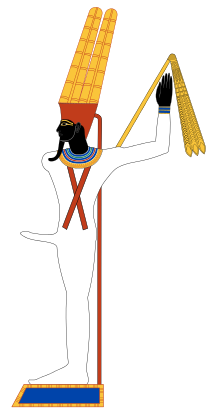Min “God of Reproduction” is an ancient Egyptian god whose cult originated in the predynastic period (4th millennium BCE). He was represented in many different forms, but was most often represented in male human form, shown with an erect penis which he holds in his right hand and an upheld left arm holding a flail.

Myth Min’s cult began and was centered around Coptos (Koptos) and Akhmim (Panopolis) of upper Egypt, where in his honour great festivals were held celebrating his “coming forth” with a public procession and presentation of offerings. His other associations include the eastern desert and links to the god Horus. Flinders Petrie excavated two large statues of Min at Qift which are now in the Ashmolean Museum, and it is thought by some that they are pre-dynastic. Although not mentioned by name, a reference to “he whose arm is raised in the East” in the Pyramid Texts is thought to refer to Min. Head of the god Min-Amun wearing the double plume. Possibly reign of Tutankhamun, 14th century BCE. From Koptos (Qift), Egypt. Petrie Museum His importance grew in the Middle Kingdom when he became even more closely linked with Horus as the deity Min-Horus. By the New Kingdom he was also fused with Amun in the form of Min-Amun, who was also the serpent Irta, a kamutef (the “bull of his mother” – a god who fathers himself with his own mother).
appearance In Egyptian art, Min is depicted as an anthropomorphic male deity with a masculine body, covered in shrouds, wearing a crown with feathers, and often holding his erect penis in his left hand and a flail (referring to his authority, or rather that of the Pharaohs) in his upward facing right hand. Around his forehead, Min wears a red ribbon that trails to the ground, claimed by some to represent sexual energy. The legs are bandaged because of his chthonic force, in the same manner as Ptah and Osiris. His skin was usually painted black, which symbolized the fertile soil of the Nile.




Comment (0)